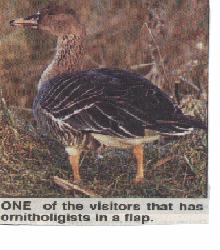
Rare geese swoop in
Home
News
About SAGS
Sustainability
Web Directory
History and Archives
Other Resources
From the Cumbernauld News & Kilsyth Chronicle
Reporting: Clare Grant

|
A Record-breaking number
of visitors - of the winged Fannyside Loch, which boasts its own nature reserve,
is playing And the high concentration of birds - more than
200 in total - RSPB Scotland's Mike Turbridge said: " This
truly is excellent "They are creatures of habit so our reserve
in Cumbernauld has Although the number of bean geese at Fannyside
is high, their They used to be the most abundant of grey geese
in Britain but Often mistaken for the more common pink-footed
goose, the bean In fact, the term 'beanfeast' or more recently
'beano' derives from While the species is flourishing elsewhere, in
Britain they remain They are rarely seen in the UK after the month
of February as that Despite the fact that their stay is relatively
short, their presence Mr Thomson is involved in the Bean Goose Action
Group, which "The first sighting of these birds was in
1980 - and we set up the "They have increased in number over the
years - and although "We wouldn't advise people to go near the
area as the chance of "However, we are thinking of organising
a visit to the site Anyone who would be interested in this event
is asked to contact |